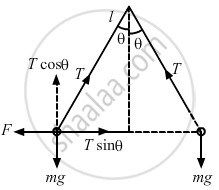Advertisements
Advertisements
प्रश्न
Two identical balls, each with a charge of 2.00 × 10−7 C and a mass of 100 g, are suspended from a common point by two insulating strings, each 50 cm long. The balls are held at a separation 5.0 cm apart and then released. Find.
(a) the electric force on one of the charged balls
(b) the components of the resultant force on it along and perpendicular to the string
(c) the tension in the string
(d) the acceleration of one of the balls. Answers are to be obtained only for the instant just after the release.
उत्तर
Given:
Magnitude of the charges, q = 2.0 × 10−7 C
Separation between the charges,
\[r = 5 \times {10}^{- 2} \]m
Length of the string,
\[l = 50 \text{ cm }= 50 \times {10}^{- 2}\] m
Mass of the balls, m = 100 g = 0.1 kg

(a) By Coulomb's Law, the electric force,
F = `("Kq"_1"q"_2)`
= `(9 xx 10^9 xx 2 xx 10^(-7) xx 2 xx 10^(-7))/((5 xx 10^(-2))^2)`
= `36/25 xx 10^(-1)`
= 0.144 N
(b) The components of the resultant force along it is zero because mg balances Tcosθ,as shown in the figure. So,
F = Tsinθ
⊥ to the string Fnet = fe cosθ − mg singθ
= `0.144(1) − 100/1000 xx 10 xx 1/20`
= `0.144 - 1/20`
= 0.094 N
(c) Tension in the string,
Tsinθ = F ..(1)
Tcosθ = mg ...(2)
Squaring equations (1) and (2) and adding, we get
\[T^2 = F^2 + \left( \text{mg } \right)^2 \]
\[ = \left( 0 . 144 \right)^2 + \left( 0 . 1 \times 9 . 8 \right)^2 \]
\[ \Rightarrow T^2 = 0 . 986\] N
(d) the acceleration of one of the balls
a = `"Fnet"/"m"`
= `0.094/0.1`
= 0.94 m/s2
APPEARS IN
संबंधित प्रश्न
Check that the ratio ke2/G memp is dimensionless. Look up a Table of Physical Constants and determine the value of this ratio. What does the ratio signify?
One end of a 10 cm long silk thread is fixed to a large vertical surface of a charged non-conducting plate and the other end is fastened to a small ball of mass 10 g and a charge of 4.0× 10-6 C. In equilibrium, the thread makes an angle of 60° with the vertical. Find the surface charge density on the plate.
Find the electric force between two protons separated by a distance of 1 fermi (1 fermi = 10−15 m). The protons in a nucleus remain at a separation of this order.
Consider a gold nucleus to be a sphere of radius 6.9 fermi in which protons and neutrons are distributed. Find the force of repulsion between two protons situated at largest separation. Why do these protons not fly apart under this repulsion?
Find the ratio of the electrical and gravitational forces between two protons.
A hydrogen atom contains one proton and one electron. It may be assumed that the electron revolves in a circle of radius 0.53 angstrom (1 angstrom = 10−10 m and is abbreviated as Å ) with the proton at the centre. The hydrogen atom is said to be in the ground state in this case. Find the magnitude of the electric force between the proton and the electron of a hydrogen atom in its ground state.
Two charged particles with charge 2.0 × 10−8 C each are joined by an insulating string of length 1 m and the system is kept on a smooth horizontal table. Find the tension in the string.
Define a unit charge.
Solve numerical example.
Three equal charges of 10×10-8 C respectively, each located at the corners of a right triangle whose sides are 15 cm, 20 cm, and 25cm respectively. Find the force exerted on the charge located at the 90° angle.
A force F acts between sodium and chlorine ions of salt (sodium chloride) when put 1 cm apart in air. The permittivity of air and dielectric constant of water are `epsilon_0` and K respectively. When a piece of salt is put in water, electrical force acting between sodium and chlorine ions 1 cm apart is ____________.
Two identical thin rings, each of radius a meter, are coaxially placed at a distance R meter apart. If Q1 coulomb and Q2 coulomb are respectively the charges uniformly spread on the two rings, the work done in moving a charge q coulomb from the centre of one ring to that of the other is ______.
A charge Q is divided into two parts of q and Q – q. If the coulomb repulsion between them when they are separated is to be maximum, the ratio of Q/q should be ______.
Coulomb's law is given by F = k q1q2 rn where n is
Two charge – 10c and + 10 c are placed 10 cm apart. Potential at centre of the line joining the two charge is:-
The capacity of an isolate conducting sphere of radius R is proportional to
The S.I unit of electric permittivity is
Identify the wrong statement in the following.
Coulomb's law correctly describes the electric force that ______
Two charges q and – 3q are placed fixed on x-axis separated by distance ‘d’. Where should a third charge 2q be placed such that it will not experience any force?
According to Coulomb's law, which is the correct relation for the following figure?

